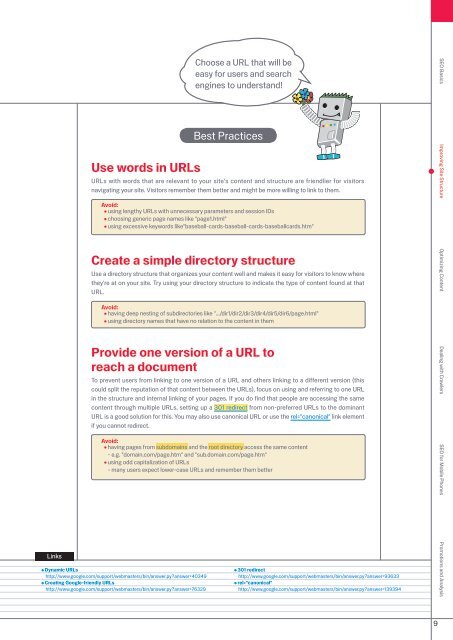Google search engine optimization starter guide
Google search engine optimization starter guide
Google search engine optimization starter guide
You also want an ePaper? Increase the reach of your titles
YUMPU automatically turns print PDFs into web optimized ePapers that Google loves.
Links<br />
Use words in URLs<br />
Dynamic URLs<br />
http://www.google.com/support/webmasters/bin/answer.py?answer=40 49<br />
Creating <strong>Google</strong>-friendly URLs<br />
http://www.google.com/support/webmasters/bin/answer.py?answer=76 9<br />
Choose a URL that will be<br />
easy for users and <strong>search</strong><br />
<strong>engine</strong>s to understand!<br />
Best Practices<br />
URLs with words that are relevant to your site's content and structure are friendlier for visitors<br />
navigating your site. Visitors remember them better and might be more willing to link to them.<br />
Avoid:<br />
using lengthy URLs with unnecessary parameters and session IDs<br />
choosing generic page names like "page1.html"<br />
using excessive keywords like"baseball-cards-baseball-cards-baseballcards.htm"<br />
Create a simple directory structure<br />
Use a directory structure that organizes your content well and makes it easy for visitors to know where<br />
they're at on your site. Try using your directory structure to indicate the type of content found at that<br />
URL.<br />
Avoid:<br />
having deep nesting of subdirectories like ".../dir1/dir /dir /dir4/dir5/dir6/page.html"<br />
using directory names that have no relation to the content in them<br />
Provide one version of a URL to<br />
reach a document<br />
To prevent users from linking to one version of a URL and others linking to a different version (this<br />
could split the reputation of that content between the URLs), focus on using and referring to one URL<br />
in the structure and internal linking of your pages. If you do find that people are accessing the same<br />
content through multiple URLs, setting up a 01 redirect from non-preferred URLs to the dominant<br />
URL is a good solution for this. You may also use canonical URL or use the rel="canonical" link element<br />
if you cannot redirect.<br />
Avoid:<br />
having pages from subdomains and the root directory access the same content<br />
- e.g. "domain.com/page.htm" and "sub.domain.com/page.htm"<br />
using odd capitalization of URLs<br />
- many users expect lower-case URLs and remember them better<br />
301 redirect<br />
http://www.google.com/support/webmasters/bin/answer.py?answer=9 6<br />
rel="canonical"<br />
http://www.google.com/support/webmasters/bin/answer.py?answer=1 9 94<br />
9<br />
SEO Basics Improving Site Structure Optimizing Content Dealing with Crawlers SEO for Mobile Phones Promotions and Analysis

















